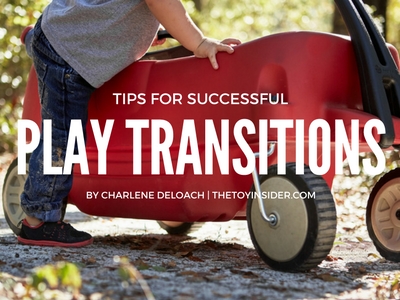
Every parent has, at one point or another, dealt with a tantrum or meltdown when asking their child to stop playing. Can you blame them? Who wants to put away the Hot Wheels to mope around the grocery store? What kid wants to set aside the LEGOs to get ready for dinner? WHO wants to stop playing Skylanders right before Kaos is about to go down, just to go to bed?
For some children (and therefore their parents), it is not an easy transition. The younger the child, the harder it is for them to “switch gears.” For children with developmental delays or certain personalities, the transitions can, more often than not, result in tantrums. It can get to the point when parents feel like they are stepping into battle when they start to utter the words, “It’s time to…” Thankfully, there are steps parents and caregivers can take to teach transitions and make them smoother over the long run. I call it the Play Transition.
While it would be the ultimate achievement to eliminate the tantrums altogether, it is somewhat of an unrealistic parenting objective. The goal is to reduce the frequency and the severity of the transition tantrums. Here are four tips to achieve that target:
Set Expectations Upfront
When starting to play a game or when pulling out the box of toys, set the expectation for your child on the length of time he or she will be able to play. For example, say that he or she can play with toys until dinner is ready. For children with awareness of time, you can give them more concrete expectations (e.g. 30 minutes).
Setting upfront expectations provides children with awareness in advance that there are rules around playtime and that it is not unending. It subconsciously lets them know there is a limit to the playtime and makes them aware of it BEFORE they start playing. The best way I can explain it is that you want to set the rules of the game in advance. Who wants to have someone change the rules mid-game? That is what it feels like to kids if you start implementing rules, deadlines, and criteria after they already start playing. Do those things up front so they know the “rules of the game” in advance.
Set a Timer
While it may be nice to say to the kids “10 more minutes!,” many children have no idea what 10 minutes feels like, looks like, or anything in between. To give them a more concrete expectation (as well as teaching them what 10 minutes is conceptually) set a timer. Whether it is the timer on your oven, on your phone, or a standalone cooking timer (there are cute ones on Amazon that you could dedicate to play time), let the kids know that the timer is set, and play stops at the buzzer! It even helps if the child can push the start button, so they are engaged in the expectation and feel like they have some control over it.
Give Warnings
Even after setting expectations and the length of time, it is still important to give warnings about the remaining time. If playtime is set to last 60 minutes, then give a verbal cue when there’s 30 minutes left, etc. My rule of thumb is to give a warning halfway through the play time, when there is 10 minutes, five minutes and one minute left. It helps start to transition awareness from imaginative play back to reality.
Focus on the Positive
When it is time to put the toy or game away, focus on the beginning of the next activity and not the end of the previous one. For example, instead of saying, “Put the game away, and come to dinner,” say “Who is excited for dinner!? Come wash up after you put your things away.” Alternatively, you can be positive about the ending and upbeat about the next activity: “That was so much fun! While we get ready for bed, tell me what you liked about the game.” By distracting them from the fact that the activity they enjoyed is over, you deflect sadness to a happier thought.
Consistency is the key to success. It will take time for kids to realize that there is structure around their play, but it will make play time happier for everyone!
